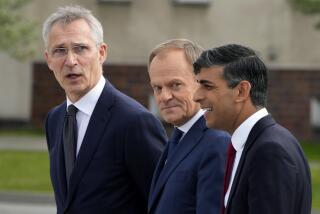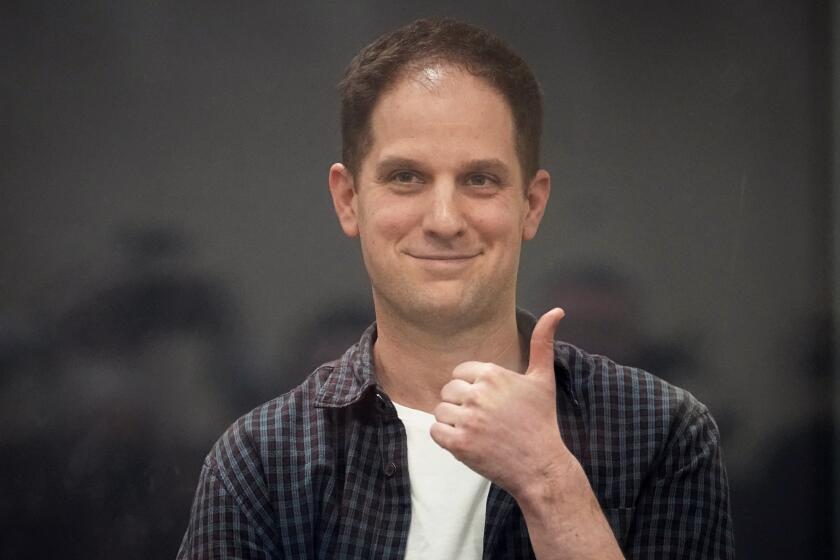Movement for Pope’s Swift Canonization Gathers Steam
Pope John Paul II’s funeral was barely underway when the cardinals seated near his casket got the first insistent message from the huge crowd below. “Santo Subito,” said the 15-foot banner unfurled in St. Peter’s Square.
Roughly translated from Italian, it means “Sainthood Now.”
Soon an identical sign popped up farther back in the crowd, followed by several minutes of cheering, rhythmic applause and shouts of “Saint John Paul!” By the end of the Mass, seven such banners were visible from the outdoor altar, each bearing the same slogan of a grass-roots movement advocating the late Roman Catholic leader’s swift sanctification.
“We all saw them,” Cardinal Theodore McCarrick of Washington, D.C., said after the service. “The message was clear. The people think he was a saint.”
Support for John Paul’s canonization “is like a tidal wave,” said Cardinal Adam Maida of Detroit. “It’s going to come.”
Vatican officials cautioned Friday that their procedure for elevating the dead to saintly status was cumbersome and could last decades. Any shortcuts, they said, would require a decision by John Paul’s successor, whom the cardinals expect to elect this month.
But in the meantime, a popular cult of sainthood is burgeoning just a week after the pope’s death. Vendors in Rome, using the Polish pontiff’s given name, are selling T-shirts proclaiming, “Saint Karol.” Makeshift shrines have sprung up near St. Peter’s, attracting handwritten notes referring in Christ-like terms to the pope’s long battle against a host of infirmities.
“The people are way ahead of the church on this,” Father Henri Guglielo, a parish priest from suburban Paris, said as he left the funeral Mass.
Friday’s pro-sainthood demonstration showed some signs of organization and looked strongest in a section of Polish pilgrims. The “Santo Subito” banners were of identical size and lettering, varying only in color.
Yet the movement itself is broad and seems primarily spontaneous, reflecting the globe-trotting pontiff’s contact with and enduring effect on millions during his 26-year reign.
“He is already a saint in our hearts,” said Elena Ramos, a black-clad Filipina, as she filed out of the square Friday. “He always was.”
Seven time zones away in Mexico, high school student Heron Badillo, 19, was up at 3 a.m. to watch the funeral on TV. He met John Paul 15 years ago when the pope landed in the city of Zacatecas and blessed the sickly boy during an airport ceremony.
In a telephone interview Friday from Zacatecas, Badillo said he strongly believed that the encounter cured him of leukemia after doctors had given up treating him. “I felt an instantaneous emotion and a new breath filling my entire body,” he said, adding that he was now free of illness.
The Mexican Bishops Conference backs his testimony. Spokeswoman Marilu Esponda said the bishops planned to present it to the Vatican, along with medical records, as evidence of a miracle, even if that wasn’t enough to put the pope on the road to canonization.
Candidates for sainthood must pass through two rigorous examinations of documents and eyewitness reports. The first leads to beatification, the second to canonization. Candidates must have proven reputations for holiness and “intercessionary” powers to deliver favors from God, as in a serious illness, to those who pray to them.
The opening of a formal case for beatification must wait at least five years after the candidate’s death, according to the rules. But many Catholics would like to see that period abolished for John Paul, and some of those would rather that the next pope skip the examination stages and simply proclaim him a saint.
Father Peter Gumpel, a member of the Vatican’s Congregation for the Causes of Saints, said such a spur-of-the-moment proclamation was unprecedented in recent centuries and would be “imprudent.”
Gumpel noted that Pope Paul VI squelched a similar movement in the 1960s to sanctify his predecessor, Pope John XXIII, right away. It took John until 2000 to achieve beatification.
Some canonization advocates accept that approach. “He is a saint to me now, so it doesn’t matter to me what happens in the formal way,” said Pole Maciej Czapiewski at the funeral. “Our pope doesn’t want special treatment, and it might be seen as being wrongly done to make him a hero. This is not pop culture. The church is 2,000 years old.”
In 1983, under John Paul’s guidance, beatification and canonization were streamlined to let people become saints faster and to offer Catholics a larger, more diverse group of examples to follow. He canonized 482 people, more than his predecessors in the last four centuries combined, according to Vatican statistics.
But some church officials believe that the next pope might feel popular pressure to move even quicker on John Paul’s beatification. The successor would have a precedent in the late pontiff’s speedy treatment of another enormously popular religious personality, Mother Teresa. Her beatification case started two years after her death in 1997 and moved at record speed to her sainthood in 2003.
“I think John Paul will also be put on a fast track,” said Cardinal Roger M. Mahony, archbishop of Los Angeles. “Everyone knows the depth of this man’s spirituality.”
Under the rules, John Paul would need to perform one miracle for beatification and one for sainthood. They would have to result from prayers to him after his death, which means that the Mexican boy’s leukemia cure, even if accepted by the Vatican as miraculous, wouldn’t count.
But the Mexican bishops will present the case anyway, in the spirit that John Paul deserves a loosening of the process.
Other Catholics believe that the church should stretch the definition of a miracle. John Paul’s evangelizing in Eastern Europe, some note, played a role in toppling the Berlin Wall.
“Absolutely, he should be recognized as a saint as soon as possible,” said Paul Lipko, a Pole attending the Mass. “What about all these people? Isn’t this a miracle?”
*
Staff writers Jeffrey Fleishman and Larry B. Stammer in Vatican City, Laura King in Rome and Cecilia Sanchez in The Times’ Mexico City Bureau contributed to this report.
*
(BEGIN TEXT OF INFOBOX)
Sainted and blessed popes through the ages
The campaign to declare the late pontiff a saint has already been launched by those calling John Paul II “the Great,” an honorific usually designated for popes worthy of sainthood. Traditionally, at least five years must elapse before a person can be considered for beatification, which precedes canonization. Here is a look at the reigns of every pope, and which ones have been beatified or canonized.
St. Peter
AD 32-67
Apostle of Jesus, and the church’s first leader.
*
Pope Liberius
352-56
Compromised by heresy; first pope not to be canonized.
*
St. Leo the Great
440-61
Emphasized pope’s supreme authority as head of church.
*
St. Gregory the Great
590-604
Church set out to establish Christianity in the Western world.
*
St. Leo III
795-816
Crowned Charlemagne emperor of the Holy Roman Empire.
*
Innocent III
1198-1216
Reign led to the Inquisition, established to investigate heresy.
*
Boniface VIII
1294-1303
Insisted that kings subject their nations to the pope.
*
Adrian VI
1522-23
Only Dutch pope, last non-Italian before John Paul II.
*
Blessed Pius IX
1846-78
Summoned Vatican Council I, declaring popes infallible in matters of faith, morals.
*
Blessed John XXIII
1958-63
Called Vatican Council II, permitting Mass in languages other than Latin.
--
Sainted popes (78): Canonization requires two verifiable miracles that must be reviewed by theologians and cardinals.
Blessed popes (10): Beatification, the traditional first step to sainthood, recognizes ascension to heaven.
Other popes (177): Sainthood, a process that can take centuries, is not bestowed on every pope.
--
Sources: New Advent Catholic Encyclopedia, World Book Encyclopedia. Graphics reporting by Brady MacDonald
More to Read
Start your day right
Sign up for Essential California for news, features and recommendations from the L.A. Times and beyond in your inbox six days a week.
You may occasionally receive promotional content from the Los Angeles Times.






